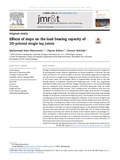Zitierlink:
http://dx.doi.org/10.25819/ubsi/10280Dateien zu dieser Ressource:
| Datei | Beschreibung | Größe | Format | |
|---|---|---|---|---|
| Effects_of_steps_on_the_load_bearing_capacity.pdf | 4.24 MB | Adobe PDF |  Öffnen/Anzeigen |
| Dokumentart: | Article | Titel: | Effects of steps on the load bearing capacity of 3D-printed single lap joints | AutorInn(en): | Khosravani, Mohammad Reza Soltani, Payam Reinicke, Prof. Dr.-Ing. Tamara |
Institut: | Department Maschinenbau | Schlagwörter: | Fracture, 3D printing, Single lap joint, Finite element analysis, Adhesively bonded joints, Bruch, 3D-Druck, Einzelne Überlappungsverbindung, Finite-Elemente-Analyse, Geklebte Verbindungen | DDC-Sachgruppe: | 620 Ingenieurwissenschaften und zugeordnete Tätigkeiten | GHBS-Notation: | ZUM | Erscheinungsjahr: | 2023 | Publikationsjahr: | 2023 | Auch erschienen: | Journal of Materials Research and Technology ; 23, S. 1834–1847. - https://doi.org/10.1016/j.jmrt.2023.01.032 | Zusammenfassung: | Damage in adhesively bonded joints typically initiates in the overlap area due to high level of bonding (peel) stress. Different approaches are being considered to decrease the peel stress and improve the overall strength of the joint. One possible approach is to shape the over lap area into a stepped form configuration and enhance the performance of the joint. In the current study, we investigate effects of stepped-shape overlap area on the load bearing capacity of additively manufactured single-lap joints. To this aim, stepped-lap adhesively bonded joints with different designs and geometries in the overlap (bonding) area are considered with 3D-printed polylactic acid (PLA) adherends using the fused deposition modeling (FDM) process. Three configurations with different step sizes are considered to manufactured a set of adhesively bonded single-lap joints and to investigate the optimum length of the steps. The results are compared with our previous experimental findings on 3D-printed conventional single-lap joints. The obtained outcomes reveal that creating steps in the overlap area has a significant influence on the structural integrity and fracture load of 3D-printed adhesive-bonded joints and the bonded structures with identical step size in boding area reveal a better performance in load carrying capacity and shows a higher fracture load. Parallel to the experimental practices, a finite element model also developed to simulate the load carrying performance of the adhesively bonded singlelap joints with equal step size and 3D-printed PLA adherends. The FE model confirms the experimental outcomes and reveals the details of the cohesive failure and damage evolution mechanism in this bonded structures with PLA printed adherends. The proposed technique has a great potential to be a competitive alternative to conventional single-lap joints made by 3D printing. The presented results can be used for further fabrication of 3D-printed joints with a better structural performance. |
Beschreibung: | Finanziert aus dem Open-Access-Publikationsfonds der Universität Siegen für Zeitschriftenartikel |
DOI: | http://dx.doi.org/10.25819/ubsi/10280 | URN: | urn:nbn:de:hbz:467-24731 | URI: | https://dspace.ub.uni-siegen.de/handle/ubsi/2473 | Lizenz: | http://creativecommons.org/licenses/by-nc-nd/4.0/ |
| Enthalten in den Sammlungen: | Geförderte Open-Access-Publikationen |
Diese Ressource ist urheberrechtlich geschützt. |
Seitenansichten
371
checked on 12.04.2025
Download(s)
242
checked on 12.04.2025
Google ScholarTM
Prüfe
Prüfe
Diese Ressource wurde unter folgender Copyright-Bestimmung veröffentlicht: Lizenz von Creative Commons


